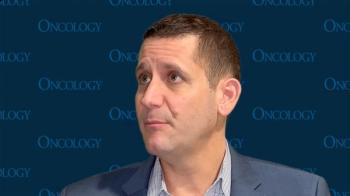
Bexmarilimab Shows Survival Efficacy in Relapsed/Refractory MDS
More follow-up data will better elucidate the impact of frontline use of hypomethylating agents in patients with myelodysplastic syndromes.
In a conversation with CancerNetwork®, Naval Daver, MD, professor and director of the Leukemia Research Alliance Program in the Department of Leukemia at MD Anderson Cancer Center in Houston, Texas, discussed how findings from the
Daver began by stressing the difficulty that emerges when comparing trials for frontline MDS treatment but highlighted 5 agents combined with hypomethylating agents tested in phase 1 trials. He further explained that these agents are typically evaluated in later-phase trials, provided they exceed benchmarks of 30% for the complete response (CR) rates and 70% for overall response rates, such as shown in the phase 3 VERONA study (NCT04401748) evaluating azacitidine plus venetoclax (Venclexta) in MDS.2
Emphasizing that overall survival (OS) is “key” when evaluating agents in the frontline setting, he remarked that the BEXMAB trial did not have adequate follow-up for an OS analysis for patients receiving bexmarilimab in the frontline setting. However, he suggested that treatment with bexmarilimab has already shown favorable efficacy among patients with relapsed/refractory MDS who experienced progression following a hypomethylating agent, showing a median OS of 13.4 months vs an expected 6 to 8 months of survival. He concluded by expressing hope that additional follow-up in the coming months will elucidate findings in the frontline setting.
Transcript:
It's always difficult to compare, but if you look at the recent trials that have looked at frontline combinations of hypomethylating agents like azacitidine, and there have been five of those in the phase 1 setting: sabatolimab [MBG453], pevonedistat [TAK-924], APR-246, magrolimab [Hu5F9-G4], and venetoclax. [A true CR rate of approximately 30%] has been what has been considered encouraging to go to phase 3 [trials]; that is what we are seeing. An overall response rate of about 70% is also similar to azacitidine-venetoclax, which is being evaluated in the phase 3 VERONA study. We have good efficacy in the frontline [setting].
Now, in the frontline [setting], OS is the key thing, and we do not yet have [enough] follow-up. It’s only an 8-month follow-up, so we do not know yet, but I would say that this is a good situation where we can start planning a frontline registration. The posthypomethylating agent, which [includes] patients who have received more than 4 cycles of a hypomethylating agent or are intolerant, there the data is [stronger] because we have a known expectation of 6- to 8-month [overall] survival…. Here [we’re] looking at 13.4 months [with BEXMAB]. Yes, it is 32 patients, not a huge data set, but relevant.
That looks like quite an encouraging survival. Both are relevant for development, but the data at this point are clearer and stronger in the posthypomethylating agent. Hopefully, in the next 6 months, we will have more follow-up and know more about the frontline [setting] as well.
References
- Daver NG, Kontro M, Rimpiläinen J, et al. Efficacy of macrophage checkpoint Clever-1 inhibition with bexmarilimab plus azacitidine in myelodysplastic syndrome: results from the ph1/2 BEXMAB study. J Clin Oncol. 2025;43(suppl 16):6513. doi:10.1200/JCO.2025.43.16_suppl.6513
- Garcia JS, Platzbecker U, Odenike O, et al. Efficacy and safety of venetoclax plus azacitidine for patients with treatment-naive high-risk myelodysplastic syndromes. Blood. 2025;145(11):1126-1135. doi:10.1182/blood.2024025464
Newsletter
Stay up to date on recent advances in the multidisciplinary approach to cancer.

















































































